Friday, August 31, 2012
Nobel Stairs in Sweden
The Nobel Prize is, of course, the most prestigious award in a number of major fields such as physics, chemistry, medicine, literature and economics. The prizes are awarded at the Stockholm Concert Hall, followed by the banquet at the Stockholm City Hall (photograph). I was told that the winner walked down these stairs to greet the guests.
We did walk up the stairs, however.
Few people can actually win the Nobel Prize. But striving to confer “the greatest benefit on mankind” is a noble course to which all of us can aspire.
Monday, August 27, 2012
Peace (and the lack of it) in Norway
Norway is the home of the Nobel Peace Prize. It has been presented in Oslo since 1901. The award ceremony is held in the Norwegian Parliament Building - on the right hand side of the photo. The building is modest in size and architecture, in comparison with parliament buildings of many other countries. But there are few places in the world that are host to such prestigious events, and graced by so many admirable people.
The prize winners stay in the Grand Hotel (on the left hand side of the photo) next to the Parliament. In addition to association with the Nobel Peace Prize, I heard that Roald Dahl got his inspiration for some of his work here, and Henrik Ibsen used to eat here everyday.
On the other hand, Norway is also the home of Anders Behring Breivik, and where he killed 77 people in 2011. He committed these atrocities to promote his far-right views, hatred of Islam and feminism, and desire to deport all Muslims from Europe. Recently he indicated that his only regret was that he did not kill more people.
Evil is lurking right where people celebrate peace and lofty ideals. Even a place as peace-loving, wealthy, educated and open-minded as Norway is not immune to evil.
The prize winners stay in the Grand Hotel (on the left hand side of the photo) next to the Parliament. In addition to association with the Nobel Peace Prize, I heard that Roald Dahl got his inspiration for some of his work here, and Henrik Ibsen used to eat here everyday.
On the other hand, Norway is also the home of Anders Behring Breivik, and where he killed 77 people in 2011. He committed these atrocities to promote his far-right views, hatred of Islam and feminism, and desire to deport all Muslims from Europe. Recently he indicated that his only regret was that he did not kill more people.
Evil is lurking right where people celebrate peace and lofty ideals. Even a place as peace-loving, wealthy, educated and open-minded as Norway is not immune to evil.
Sunday, August 26, 2012
Up in the Mountains of Norway
 Just hours away from Bergen by car and hidden in the mountains, there are fantastically green valleys with winding streams and no more than a handful houses. People come here to hike, ride their bicycles, and camp. Here you don’t have to talk to people if you don’t want to.
Just hours away from Bergen by car and hidden in the mountains, there are fantastically green valleys with winding streams and no more than a handful houses. People come here to hike, ride their bicycles, and camp. Here you don’t have to talk to people if you don’t want to. 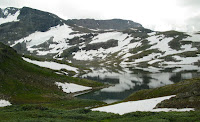 Snow-fed pristine lakes dotted the mountains. Often it is difficult to tell which is a mountain, which is snow, and which is simply a reflection.
Snow-fed pristine lakes dotted the mountains. Often it is difficult to tell which is a mountain, which is snow, and which is simply a reflection.  Some glaciers seem to test the waters of the fjords with their feet. Many more just lie there quietly up in the mountains, nevertheless only hours away from Bergen.
Some glaciers seem to test the waters of the fjords with their feet. Many more just lie there quietly up in the mountains, nevertheless only hours away from Bergen. Here one can feel totally alone. Where one stands, it is quite possible that no one else has been here before. It can be scary. It can also be liberating.
Saturday, August 25, 2012
Bergen
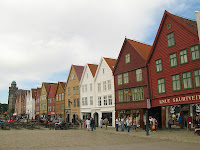 Bergen, on the west coast opening onto the North Sea, was the capital of Norway at one point. Here there is a row of old wooden houses on the water front - the famous Bryggen (Norwegian for wharf), or Tyskebryggen (German for wharf). Bergen was an important port for the Hanseatic League and these were warehouses. They are hundreds of years old, sitting on a foundation of big wooden logs. The foundation logs have been rotting, the houses have been sinking, and getting tilted and crooked. It is said they remain standing because they are leaning on each other. Great efforts have been undertaken to shore up these houses. In Hong Kong and China, they would have been torn down a long time ago.
Bergen, on the west coast opening onto the North Sea, was the capital of Norway at one point. Here there is a row of old wooden houses on the water front - the famous Bryggen (Norwegian for wharf), or Tyskebryggen (German for wharf). Bergen was an important port for the Hanseatic League and these were warehouses. They are hundreds of years old, sitting on a foundation of big wooden logs. The foundation logs have been rotting, the houses have been sinking, and getting tilted and crooked. It is said they remain standing because they are leaning on each other. Great efforts have been undertaken to shore up these houses. In Hong Kong and China, they would have been torn down a long time ago.  In Bergen you can get a taste of whale meat. It is minke, a kind of baleen whale which is said to be still relatively plentiful. The total population has been estimated by different organizations differently, ranging from 300,000 to 600,000. Some might consider it simply a different kind of meat. Others might find it to be another assault on nature. It does taste like lean beef.
In Bergen you can get a taste of whale meat. It is minke, a kind of baleen whale which is said to be still relatively plentiful. The total population has been estimated by different organizations differently, ranging from 300,000 to 600,000. Some might consider it simply a different kind of meat. Others might find it to be another assault on nature. It does taste like lean beef.Friday, August 24, 2012
Norway's glaciers
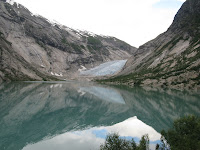 A foot of the Jostedal Glacier reaches almost all the way down to a fjord. A small boat deposited us on the bank at a spot closest to the glacier, probably only a couple hundred meters away. However, it took us half an hour to climb over the huge boulders blocking our way. We were fortunate in that it didn’t rain. Even then it was quite slippery and some of us did not try to reach the glacier. If it did rain none of us would have tried.
A foot of the Jostedal Glacier reaches almost all the way down to a fjord. A small boat deposited us on the bank at a spot closest to the glacier, probably only a couple hundred meters away. However, it took us half an hour to climb over the huge boulders blocking our way. We were fortunate in that it didn’t rain. Even then it was quite slippery and some of us did not try to reach the glacier. If it did rain none of us would have tried.  The short hike was worth it. Some of the ice have melted, leaving behind some of the dirt, making the glacier look kind of dirty on the surface. Even then, the ice appeared translucent, and deeply blue. I read that ice is blue for the same reason that water is blue - because the water molecule absorbs light at the red end of the visible spectrum. The ice was cold, of course. But the air was simply refreshingly cool. It took your mind away from the worries of the world - if only for a moment.
The short hike was worth it. Some of the ice have melted, leaving behind some of the dirt, making the glacier look kind of dirty on the surface. Even then, the ice appeared translucent, and deeply blue. I read that ice is blue for the same reason that water is blue - because the water molecule absorbs light at the red end of the visible spectrum. The ice was cold, of course. But the air was simply refreshingly cool. It took your mind away from the worries of the world - if only for a moment. Not far from the glacier, cute little houses line up neatly on the edge of the fjord. Rare where I live, but a common sight in Norway. It is a privilege to live in a civilized way, yet so close to raw nature.
Not far from the glacier, cute little houses line up neatly on the edge of the fjord. Rare where I live, but a common sight in Norway. It is a privilege to live in a civilized way, yet so close to raw nature. Tuesday, August 21, 2012
Fjords of Norway
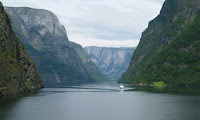 The fjords of Norway are really beautiful. They are long, narrow, and crooked. They are bounded by soaring mountains, with streams of rocks rolling down the mountains. There are occasional patches of bright green, sloping fields, some of which are dotted with small, colorful houses. The water is calm, clean, cold and dark.
The fjords of Norway are really beautiful. They are long, narrow, and crooked. They are bounded by soaring mountains, with streams of rocks rolling down the mountains. There are occasional patches of bright green, sloping fields, some of which are dotted with small, colorful houses. The water is calm, clean, cold and dark.  The calm is broken by an occasional dolphin (porpoise?) jumping out of the water. But they are really hard to catch - with a camera, I mean.
The calm is broken by an occasional dolphin (porpoise?) jumping out of the water. But they are really hard to catch - with a camera, I mean.
 Everywhere one looks, it is as beautiful as a postcard. But this is summer. How does one live here in winter?
Everywhere one looks, it is as beautiful as a postcard. But this is summer. How does one live here in winter? Saturday, August 18, 2012
Beautiful, independent Norway
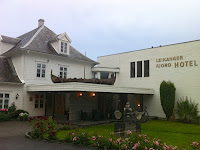
 It is easy to like Norway. There is a lot of open space, even in cities like Oslo and Bergen. The people are polite. The place is clean. There are a lot of interesting sights such as narrow, long, and deep fjords, snow capped mountains even in the height of summer, and fairly-accessible glaciers.
It is easy to like Norway. There is a lot of open space, even in cities like Oslo and Bergen. The people are polite. The place is clean. There are a lot of interesting sights such as narrow, long, and deep fjords, snow capped mountains even in the height of summer, and fairly-accessible glaciers. 
 There are still quite a few quaint little houses with grass growing on the roof. I was told that the grass was supposed to help to keep the house warm. But the practice is disappearing.
There are still quite a few quaint little houses with grass growing on the roof. I was told that the grass was supposed to help to keep the house warm. But the practice is disappearing.The people are amazingly independent. A lot of them still live in isolated, small houses high on the mountains, or deep inside fjords. Many are unreachable by road, and accessible only by boat. It is not easy living there even in summer, and almost unimaginable deep in winter. One must be stubbornly self-sufficient to be able to live in such places.
Perhaps that’s part of the reason why they can achieve so much with so few people. Of course, having discovered a tremendous amount of oil offshore under the North Sea helps a lot.
Wednesday, August 08, 2012
Hamlet's Castle
Kronberg Castle in Denmark is a star-shaped fortress. It is situated at the north-east of Denmark, where the North Sea passes into the Baltic Sea. This is also the point where Denmark is closest to Sweden, where the channel is only 4 kilometer wide. Standing on the shore in front of the castle, we could see clearly the land and the buildings on the opposite shore. It is obviously a strategic location.
Kronberg was an important castle in its own right in the history of Denmark. But it was made world-famous as Elsinore in Shakespeare's Hamlet. It is an engaging story, but it is so tragic. Perhaps people love it precisely because it is such a sad story? Why is it that we tend to be touched more by tragic story than by happy ones?
Monday, August 06, 2012
The people of Denmark
The Little Mermaid seems to be saying to us, "What are you gawking at?" Who are we? Bus loads of tourists, boat loads of tourists, warships, ...
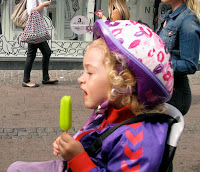
At Hamlet's castle, we met this baby with a big rounded head, big rounded eyes, and big smiles. Initially I thought he was a boy. Later I was told she was probably a girl. He/she was just so lovely. I thought he liked me when he turned his attention to me. It turned out he was trying to grab my camera.

One of their heroes is, of course, Hans Christian Anderson. And he seems to like children. At least, the children like him.

Other than children, bicycles are also everywhere. It is not just the athletic types that ride bicycles. People in suits, dresses, high heels, ... are riding them to work and everywhere.
There seems to be a lot of babies and children.
Or perhaps it is simply that the people here like taking their babies and children out.



Subscribe to:
Posts (Atom)





